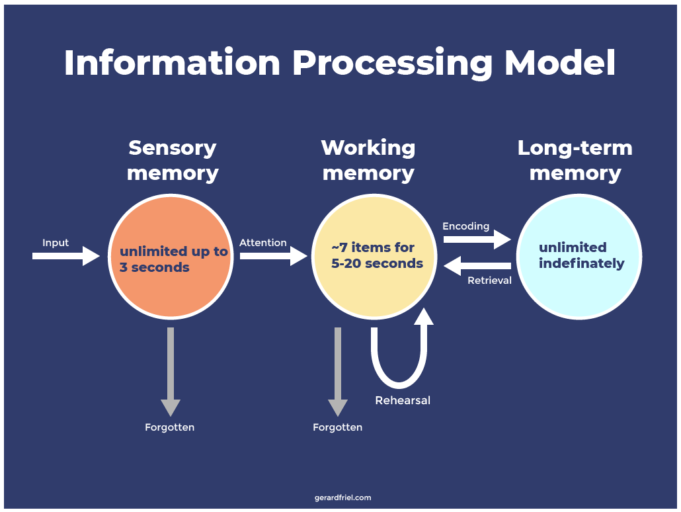How memory usage can be optimised in learning design.
What is cognitive load theory?
Cognitive Load Theory was initially developed by psychologist John Sweller in the late 1980s and covers how short and long-term memory operates. People have limited capacity in short or ‘working’ memory and appropriate learning designs can reduce working memory load and promote transfer of knowledge into long-term memory.
Atkinson and Shiffrin’s memory processing model shows the role working memory plays in the learning process and Cognitive Load Theory can be applied to limit unnecessary effort in this area.

Three types of Cognitive Load exist:
- Intrinsic – the actual difficulty of the subject matter itself. Instructional design has less influence on this than the other load types.
- Extraneous – unnecessary distraction and increase in cognitive load without benefiting the learning such as decorative graphics that don’t serve a learning purpose.
- Germaine – highly beneficial and can help the learners move information from working to long-term memory via models and mental connections.
Examining how learners process content will influence your design decisions.
Why is this important?
Poor instructional design can lead to overloading a learner’s limited working memory. People can only hold between five and nine items in their working memory. As soon as the next item arrives, one drops out if it hasn’t already been consigned to long-term memory.
Incoming information is mainly received through two channels: audio and visual, and these can quite often compete for attention. These two channels are used extensively in digital learning and when there is friction between the two, cognitive load is increased and has a negative impact on learning.
How can I apply Cognitive Load Theory?
The aim for instructional design is to make intrinsic clearer, reduce extraneous and promote germane cognitive loads. Some methods for each load include:
- Intrinsic – break complex tasks into smaller, sequenced chunks and then bring them together to provide the whole picture; provide worked examples for new concepts; simplify content where possible and reduce redundancy/repetition.
- Extraneous – keep related text and images in close proximity; reduce visual and audio competition by not narrating all on screen text; and remove decorative graphics.
- Germaine – activate prior learning or experiences so learners can build on their existing mental models; and provide opportunities to practice exchange of information between the memory types.
By implementing some of these strategies, you will reduce the load in your learner’s working memory and enhance their ability to commit new information to long-term memory and meet your learning goals.
Review

Pros: Essential guidelines for making digital learning design decisions.
Cons: Intrinsic cognitive load can be difficult to manage if the subject matter is inherently complex.
Related reading: Instructional Design, Bloom
